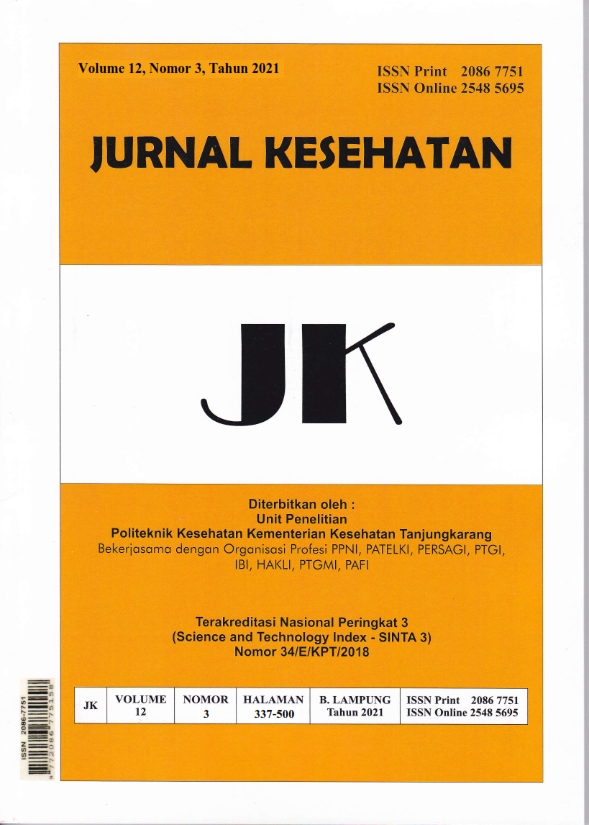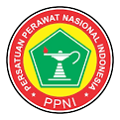Perbandingan Profil Lipid dan Penanda Inflamasi pada Pria Obesitas dan Non-Obesitas
DOI:
https://doi.org/10.26630/jk.v12i3.2923Keywords:
Inflamation, Lipid profile, Obesity.Abstract
Obesity is a global health problem suffered by people around the world, including Indonesian. Adipose tissue dysfunction and fat distribution are affecting the incidence of obesity-related diseases. The study aimed to compare the levels of lipid profiles (total cholesterol, HDL, LDL, and triglycerides) and inflammatory markers (ESR and leukocyte count) between groups with normal nutritional status and obesity. Data were collected using a cross-sectional study with 14 young adult men for the normal nutritional status group with a BMI of 18,5-24,99kg/m2 and 14 young adult men for the obese group with a BMI ³25 kg/m2 in August-December 2019. The respondents aged 18-35 years were measured body composition and tested for levels of lipid profiles and inflammatory markers. The results of statistical tests with independent t-test showed no difference in the number of leukocytes (p-value=0.08) but there was a significant difference in ESR (25,1±14,1 vs 47,2±23,7,p-value=0,006), total cholesterol (126,6±26,4 vs 175,5±32,0, p-value=0,001), triglycerides (113,3±38,3 vs 161,5±46,9,p=0,006) and LDL (53±18,4 vs 95±27,3, p-value=0,001). This study concludes that there are significant differences in levels of total cholesterol, triglycerides, LDL, and ESR between groups of individuals with normal nutritional status and obesity.
References
Bays, H. E., Toth, P. P., Kris-Etherton, P. M., Abate, N., Aronne, L. J., Brown, W. V., Gonzalez-Campoy, J. M., Jones, S. R., Kumar, R., La Forge, R., & Samuel, V. T. (2013). Obesity, adiposity, and dyslipidemia: A consensus statement from the National Lipid Association. Journal of Clinical Lipidology, 7(4), 304-383. https://doi.org/10.1016/j.jacl.2013.04.001.
Björnson, E., Adiels, M., Taskinen, M. R., & Borén, J. (2017). Kinetics of plasma triglycerides in abdominal obesity. Current opinion in lipidology, 28(1), 11-18. https://doi.org/10.1097/MOL.0000000000000375.
Blüher M. (2020). Metabolically Healthy Obesity. Endocrine reviews, 41(3), 405-420. https://doi.org/10.1210/endrev/bnaa004.
Boutens, L., & Stienstra, R. (2016). Adipose tissue macrophages: going off track during obesity. Diabetologia, 59(5), 879-894. https://doi.org/10.1007/s00125-016-3904-9
Chan, D. C., Barrett, H. P., & Watts, G. F. (2004). Dyslipidemia in visceral obesity: mechanisms, implications, and therapy. American journal of cardiovascular drugs: drugs, devices, and other interventions, 4(4), 227-246. https://doi.org/10.2165/00129784-200404040-00004.
Dash, S., Xiao, C., Morgantini, C., & Lewis, G. F. (2015). New Insights into the Regulation of Chylomicron Production. Annual review of nutrition, 35, 265–294. https://doi.org/10.1146/annurev-nutr-071714-034338
Day, C., & Bailey, C. J. (2011). Obesity in the pathogenesis of type 2 diabetes. The British Journal of Diabetes & Vascular Disease, 11(2), 55-61. https://doi.org/10.1177/1474651411407418
Goossens G. H. (2008). The role of adipose tissue dysfunction in the pathogenesis of obesity-related insulin resistance. Physiology & behavior, 94(2), 206-218. https://doi.org/10.1016/j.physbeh.2007.10.010
Grundy, S. M. (2004). Obesity, Metabolic Syndrome, and Cardiovascular Disease. The Journal of Clinical Endocrinology & Metabolism, 89(6), 2595-2600. https://doi.org/10.1210/jc.2004-0372.
Jacome-Sosa, M. M., & Parks, E. J. (2014). Fatty acid sources and their fluxes as they contribute to plasma triglyceride concentrations and fatty liver in humans. Current opinion in lipidology, 25(3), 213-220. https://doi.org/10.1097/MOL.0000000000000080.
Kang, Y. E., Kim, J. M., Joung, K. H., Lee, J. H., You, B. R., Choi, M. J., Ryu, M. J., Ko, Y. B., Lee, M. A., Lee, J., Ku, B. J., Shong, M., Lee, K. H., & Kim, H. J. (2016). The Roles of Adipokines, Proinflammatory Cytokines, and Adipose Tissue Macrophages in Obesity-Associated Insulin Resistance in Modest Obesity and Early Metabolic Dysfunction. PloS one, 11(4), e0154003. https://doi.org/10.1371/journal.pone.0154003.
Karastergiou, K., Smith, S. R., Greenberg, A. S., & Fried, S. K. (2012). Sex differences in human adipose tissues - the biology of pear shape. Biology of sex differences, 3(1), 13. https://doi.org/10.1186/2042-6410-3-13.
Kementerian Kesehatan RI. (2018). Laporan Nasional Riset Kesehatan Dasar 2018. Badan Penelitian dan Pengembangan Kesehatan Kemenkes RI.
Khovidhunkit, W., Kim, M. S., Memon, R. A., Shigenaga, J. K., Moser, A. H., Feingold, K. R., & Grunfeld, C. (2004). Effects of infection and inflammation on lipid and lipoprotein metabolism: mechanisms and consequences to the host. Journal of lipid research, 45(7), 1169-1196. https://doi.org/10.1194/jlr.R300019-JLR200.
Kyrou, I., Randeva, H. S., Tsigos, C., Kaltsas, G., & Weickert, M. O. (2018). Clinical Problems Caused by Obesity. In K. R. Feingold (Eds.) et. al., Endotext. MDText.com, Inc.
Matheson, E. M., King, D. E., & Everett, C. J. (2012). Healthy lifestyle habits and mortality in overweight and obese individuals. Journal of the American Board of Family Medicine: JABFM, 25(1), 9-15. https://doi.org/10.3122/jabfm.2012.01.110164
Mandviwala, T., Khalid, U., & Deswal, A. (2016). Obesity and Cardiovascular Disease: a Risk Factor or a Risk Marker?. Current atherosclerosis reports, 18(5), 21.
https://doi.org/10.1007/s11883-016-0575-4
Qatanani, M., & Lazar, M. A. (2007). Mechanisms of obesity-associated insulin resistance: many choices on the menu. Genes & development, 21(12), 1443-1455. https://doi.org/10.1101/gad.1550907.
Ryder, E., Diez-Ewald, M., Mosquera, J., Fernández, E., Pedreañez, A., Vargas, R., … Fernández, N. (2014). Association of obesity with leukocyte count in obese individuals without metabolic syndrome. Diabetes & Metabolic Syndrome: Clinical Research & Reviews, 8(4), 197-204. doi:10.1016/j.dsx.2014.09.002.
Stinkens, R., Goossens, G. H., Jocken, J. W., & Blaak, E. E. (2015). Targeting fatty acid metabolism to improve glucose metabolism. Obesity reviews: an official journal of the International Association for the Study of Obesity, 16(9), 715-757. https://doi.org/10.1111/obr.12298
WHO. (2021). Obesity and overweight. https://www.who.int/news-room/fact-sheets/detail/obesity-and-overweight.
Xiao, C., Dash, S., Morgantini, C., Hegele, R. A., & Lewis, G. F. (2016). Pharmacological Targeting of the Atherogenic Dyslipidemia Complex: The Next Frontier in CVD Prevention Beyond Lowering LDL Cholesterol. Diabetes, 65(7), 1767-1778. https://doi.org/10.2337/db16-0046
Yu, Y. H., & Ginsberg, H. N. (2005). Adipocyte Signaling and Lipid Homeostasis. Circulation Research, 96(10), 1042-1052.https://doi.org/10.1161/01.res.0000165803.47776.38.
Zalesin, K. C., Franklin, B. A., Miller, W. M., Peterson, E. D., & McCullough, P. A. (2011). Impact of obesity on cardiovascular disease. The Medical clinics of North America, 95(5), 919-937. https://doi.org/10.1016/j.mcna.2011.06.005.
Downloads
Published
Issue
Section
License
Copyright (c) 2021 Jurnal Kesehatan

This work is licensed under a Creative Commons Attribution-ShareAlike 4.0 International License.
Authors who publish in this journal agree to the following terms:
- Authors retain copyright and grant the journal right of first publication with the work simultaneously licensed under a Creative Commons Attribution License (CC BY-SA 4.0) that allows others to share the work with an acknowledgment of the work's authorship and initial publication in this journal.
- Authors can enter into separate, additional contractual arrangements for the non-exclusive distribution of the journal's published version of the work (e.g., post it to an institutional repository or publish it in a book), with an acknowledgment of its initial publication in this journal.
- Authors are permitted and encouraged to post their work online (e.g., in institutional repositories or on their website) prior to and during the submission process, as this can lead to productive exchanges and earlier and greater citations of published work.












